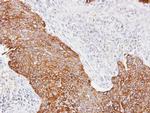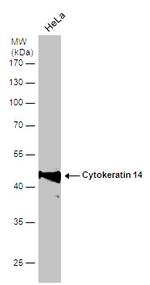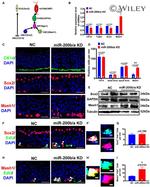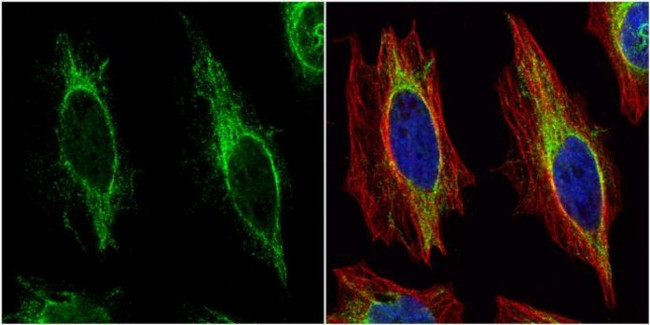Search Thermo Fisher Scientific
Invitrogen
Cytokeratin 14 Polyclonal Antibody
FIGURE: 1 / 4
Cytokeratin 14 Antibody (PA5-28002) in ICC/IF




Product Details
PA5-28002
Species Reactivity
Published species
Host/Isotype
Class
Type
Immunogen
Conjugate
Form
Concentration
Purification
Storage buffer
Contains
Storage conditions
Shipping conditions
RRID
Product Specific Information
Recommended positive controls: HeLa, rat olfactory epithelium.
Predicted reactivity: Mouse (95%), Rat (94%), Dog (96%), Bovine (96%).
Store product as a concentrated solution. Centrifuge briefly prior to opening the vial.
Target Information
Cytokeratins (CK) are intermediate filaments of epithelial cells, both in keratinizing tissue (ie. skin) and non-keratinizing cells (ie. mesothelial cells). At least 20 different CKs can be identified. Biochemically, most members of the CK family fall into one of two classes, type I (acidic polypeptides) and type II (basic polypeptides). Belonging to the type I subfamily of low molecular weight keratins and existing in combination with keratin 5, keratin 14 distinguishes stratified epithelial cells from simple epithelial cells and is useful in identification of squamous cell carcinomas. It is considered a prognostic marker in breast carcinomas. At least one member of the acidic family and one member of the basic family is expressed in all epithelial cells.
For Research Use Only. Not for use in diagnostic procedures. Not for resale without express authorization.
Bioinformatics
Protein Aliases: CK-14; cytokeratin 14; Cytokeratin-14; K14; keratin 14 (epidermolysis bullosa simplex, Dowling-Meara, Koebner); keratin 14, type I; keratin complex 1, acidic, gene 14; Keratin, type I cytoskeletal 14; Keratin-14; Koebner; Type I keratin Ka14
Gene Aliases: CK14; EBS3; EBS4; K14; Ka14; Krt1-14; KRT14; NFJ
UniProt ID: (Human) P02533, (Rat) Q6IFV1
Entrez Gene ID: (Human) 3861, (Rat) 287701

Performance Guarantee
If an Invitrogen™ antibody doesn't perform as described on our website or datasheet,we'll replace the product at no cost to you, or provide you with a credit for a future purchase.*
Learn more
We're here to help
Get expert recommendations for common problems or connect directly with an on staff expert for technical assistance related to applications, equipment and general product use.
Contact tech support
